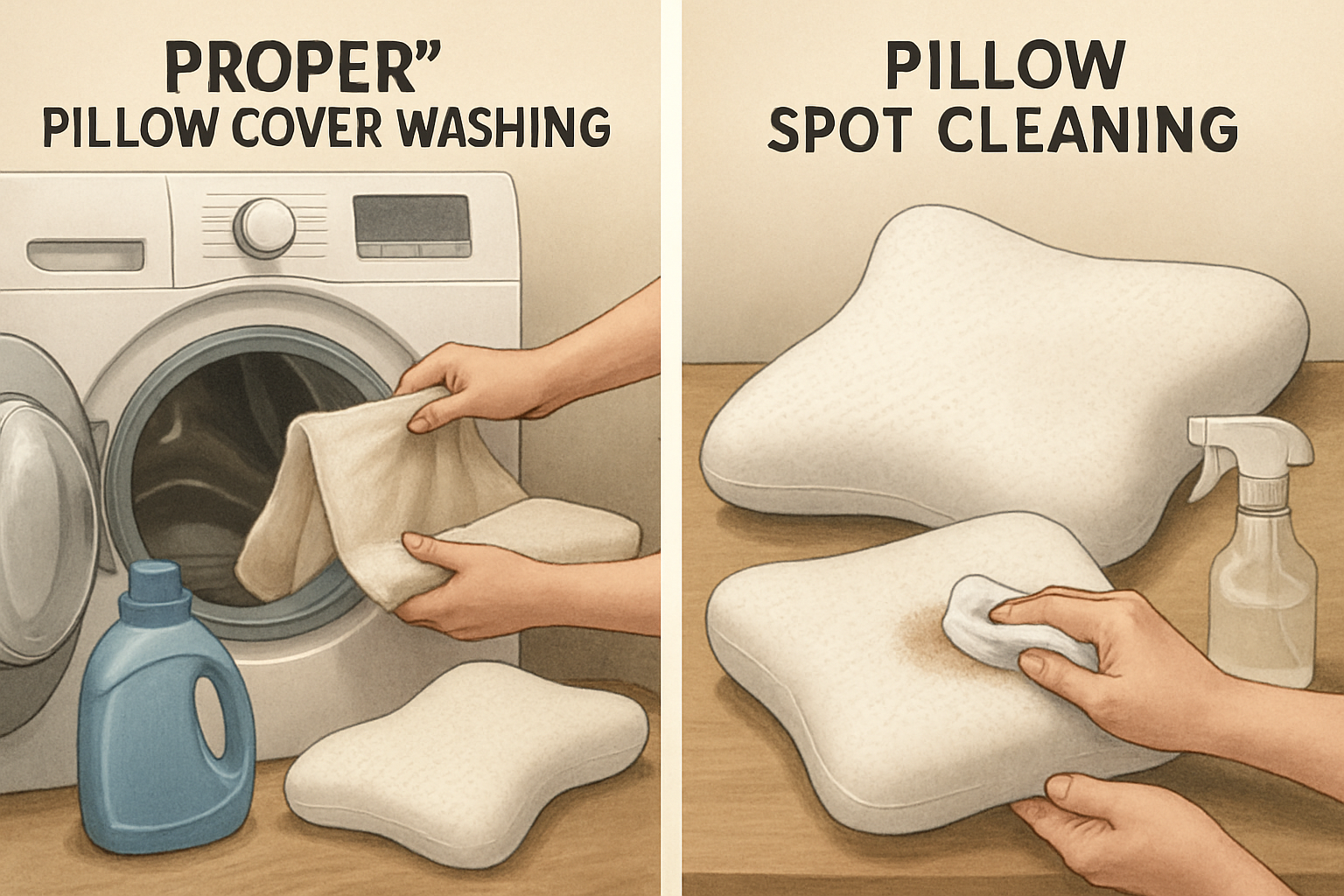TL;DR: A memory foam pillow for neck pain supports your natural spine alignment, reducing stiffness and discomfort for better sleep. This guide covers everything from choosing to maintaining your pillow for optimal relief.
Everyone knows waking up with neck pain ruins your day.
But what makes a memory foam pillow for neck pain so effective?
This article is your complete cheatsheet to choosing, using, and caring for one.
Some are contoured to cradle the neck perfectly.
Some feature cooling technology to prevent overheating.
Some pillows let you adjust firmness for personalized comfort.
Some combine natural fibers with memory foam for breathability.
Some models come with a 100-night trial to ensure satisfaction.
Let's dive right in.
What Is a Memory Foam Pillow and How Does It Help Neck Pain?
A memory foam pillow is designed to mold precisely to your head and neck shape, providing tailored support.
Unlike traditional feathers or polyester pillows, memory foam offers firm yet comfortable cushioning that evenly distributes pressure.
How does this benefit neck pain sufferers? It promotes neutral spinal alignment by filling the gap between your head and shoulders, preventing unnatural bending of the neck while you sleep.
Dr. Naimish Baxi, a physiatrist, explains that pillows keeping your ears aligned with your shoulders protect your spine from strain and stiffness (source).
Memory foam also reduces tossing and turning by cradling your head steadily through the night.

How to Choose the Right Memory Foam Pillow for Neck Pain
Choosing a memory foam pillow isn’t as simple as grabbing the fluffiest option. Consider these expert factors to ensure maximum relief and comfort.
1. Consider Your Sleeping Position
- Side sleepers: Need a thicker, firmer pillow to fill the shoulder-neck gap, supporting neutral spine alignment. A contoured memory foam pillow can make a big difference.
- Back sleepers: Benefit from a medium loft that supports the curve of the neck without pushing the head too far forward.
- Stomach sleepers: Usually require a thinner, softer pillow or sometimes no pillow at all to avoid excessive neck extension.
The Groove® Pillow, for example, is acclaimed for its ergonomic dip design supporting back and side sleepers by promoting neutral spine alignment (source).
2. Look for Adjustable Fill Options
Adjustability is key for a personalized fit. Some pillows like the Coop Home Goods Original allow you to add or remove shredded memory foam to tailor firmness and loft (source).
This adaptability helps if your body changes or if you share your bed with a partner.
3. Choose Cooling Features if You Sleep Hot
Memory foam often traps heat, causing discomfort. Some advanced pillows infuse cooling gel or use breathable covers made from bamboo or cotton to regulate temperature.
The Tempur-Pedic Tempur Neck Pillow offers cooling covers for hot sleepers while maintaining firm support (source).
4. Opt for Contoured or Cervical Designs
These pillows feature unique shapes that fit the natural curve of your neck and shoulders, improving posture and reducing tension headaches.
Contoured pillows have been tested and praised for stabilizing the neck in side and back sleeping positions, avoiding harmful tilt or bending.
5. Material Quality and Certifications
Look for memory foam pillows that are hypoallergenic, dust mite resistant, and have removable, washable covers.
Materials like bamboo charcoal memory foam add antibacterial properties and freshness (source).
Quick Tip: Always check the pillow dimensions and ensure it fits your standard pillowcase, or consider buying brand-specific cases for contoured pillows.

Can I Make My Own Memory Foam Pillow at Home?
Absolutely! Creating a DIY orthopedic pillow is a great way to customize support for your neck pain.
According to Puffy, making your own pillow lets you adjust firmness, shape, and materials to fit your personal needs rather than settling for an off-the-shelf product (source).
Essential Materials
- High-density memory foam or shredded latex for supportive filling.
- Breathable fabric such as cotton or bamboo for a comfortable cover.
- Measuring tape, scissors, and sewing tools.
- Zippers can be added for removable covers for easier washing.
Step-by-Step Guide
- Measure the ideal pillow size; standard is about 20” x 12”, but adjust for your preferences.
- Cut the memory foam into a contoured shape supporting your neck curve.
- Sew a fabric cover slightly larger than the foam size.
- Insert foam, then close with a seam or zipper.
- Test by lying down and adjust foam density if needed.
This hands-on approach allows thorough customization often not available with commercial pillows.
How to Care for Your Memory Foam Pillow to Ensure Longevity
Proper care preserves support and hygiene, extending the pillow’s useful life.
Here’s how to maintain your memory foam pillow effectively:
1. Use a Removable, Washable Cover
This prevents dust, sweat, and oils from reaching the foam itself. Wash covers regularly according to fabric care instructions.
2. Spot Clean the Foam Only
Never submerge memory foam in water, which can damage it. Instead, use a mixture of mild detergent and warm water with a soft cloth to treat stains gently. Air dry completely before reuse.
3. Deodorize Regularly
Sprinkle baking soda over the pillow, let sit for at least 30 minutes, then vacuum it off to keep forms fresh and odor-free.
4. Avoid Direct Sunlight and Heat
Excess sun or heat can degrade the foam’s structure and cause it to lose support.
5. Replace When Necessary
Even the best memory foam pillows wear out over time. If you notice flattening or worsening neck pain, it’s time for a replacement.

What Does the Research Say About Memory Foam Pillows for Neck Pain?
Many studies and expert reviews support the use of memory foam for relieving neck pain.
The Good Housekeeping Institute tested over 200 pillows, finding firm memory foam pillows, especially contoured ones, provide superior neck support and reduce morning stiffness (source).
Some users indicated switching to memory foam pillows dramatically improved sleep quality, reduced soreness, and minimized headaches after waking.
Another notable example is the Groove® Pillow, which has been recommended by over 850 medical practitioners for neck pain relief and posture correction during sleep (source).
Furthermore, orthopedic pillows incorporating memory foam encourage neutral spine alignment, which can alleviate tension not only in the neck but also shoulders and upper back.
Experts emphasize that the best memory foam pillow is one that suits your personal sleeping style and body shape — there is no one-size-fits-all solution.
Did you know? Proper sleeping posture backed by the right pillow can reduce tension headaches substantially by preventing nerve compression during sleep.How Do Memory Foam Pillows Compare to Other Pillow Materials for Neck Pain?
Let’s compare memory foam with other popular fills to better understand its strengths and weaknesses:
Memory Foam
- Provides firm, contouring support that molds to your neck shape.
- Excellent for pressure relief and spinal alignment.
- Tends to retain heat, but cooling technology is improving this.
- Durable with lasting shape retention.
Latex
- Also supportive and resilient, with a bouncy feel.
- More breathable than memory foam, so cooler at night.
- Natural latex is hypoallergenic and antimicrobial.
- Usually more expensive.
Down and Feather
- Soft, plush feel with lightweight comfort.
- Less supportive and can lose shape, worsening neck pain if too flat. >
- Best for stomach sleepers or those who prefer soft pillows.
Polyester Fill
- Affordable and widely available.
- Less durable and supportive compared to memory foam or latex.
- Doesn’t contour well to the neck.
Considering neck pain, memory foam and latex pillows generally rank higher for support and spinal health, while down and polyester offer comfort but less structural support.
Looking for a precise fit? Making a hybrid pillow combining memory foam with soft, natural fibers is an option to explore.
Curious about other ways to improve your daily comfort? Check out our blog posts to find tailored guides and expert advice.What Are the Benefits of Using a Memory Foam Pillow for Neck Pain?
Several benefits make memory foam pillows stand out for individuals seeking neck pain relief:
- Enhanced spinal alignment: By supporting the natural curve of your neck, they help prevent stiffness and soreness.
- Pressure relief: The foam reduces tension hotspots that often cause discomfort after waking.
- Improved sleep quality: Steady support reduces tossing and turning, promoting deeper rest.
- Reduction in headaches: Proper neck alignment cuts down on tension headaches related to poor posture.
- Durable support: Memory foam maintains its shape longer than many traditional pillows.
- Customization: Adjustable pillows allow you to tailor loft and firmness for your needs.
Medical practitioners increasingly recommend these pillows for patients with chronic neck pain, including conditions like cervical radiculopathy or arthritis (source).

Can Memory Foam Pillows Help With Shoulder Pain and Other Issues?
Yes. Correct spinal alignment impacts not only your neck but also the shoulders and upper back.
By supporting the neck’s natural curve, memory foam pillows reduce pressure on shoulder joints and muscles.
Many users report fewer shoulder stiffness and tension headaches after switching to ergonomic memory foam pillows (source).
Additionally, some designs specifically accommodate shoulder width for side sleepers, preventing numbness or tingling caused by compressed nerves during sleep.
How Can I Make the Most Out of My Memory Foam Pillow for Neck Pain?
To maximize benefits, consider these practical tips:
- Place your pillow correctly: Back sleepers should rest their head in the ergonomic dip; side sleepers should use the raised edges designed to support the neck.
- Avoid stacking multiple pillows: This can misalign your neck and negate the pillow’s benefits.
- Combine with a supportive mattress: A good mattress enhances spinal alignment and complements pillow support. For instance, Puffy’s hybrid mattresses pair well with their orthopedic pillows (source).
- Stick with a consistent sleep position: Frequent position changes may undermine your pillow’s support.
- Replace old pillows: Worn-out pillows contribute to neck discomfort.
Quick Tip: If you experience cold sensitivity from memory foam, try a pillow with a cooling cover or breathable fibers.
What Are the Best Memory Foam Pillows on the Market for Neck Pain?
Several models stand out based on expert reviews and consumer satisfaction:
Tempur-Pedic Tempur Neck Pillow
Famous for its extra-firm memory foam and contoured shape. It keeps ears aligned with shoulders and supports back and side sleeping styles.
Coop Home Goods Original Adjustable Pillow
Offers adjustable shredded memory foam fill for customized loft and firmness. Affordable and widely praised for comfort across sleeping positions.
Groove® Original Memory Foam Pillow
Ergonomic dip design with bamboo charcoal memory foam, favored by thousands and recommended by medical practitioners for neck pain relief (source).
Layla Adjustable Kapok Pillow
Uses a mix of shredded memory foam and natural kapok fiber offering a plush yet supportive feel. Adjustable for various sleep preferences.
Tuft & Needle Original Foam Pillow
Solid memory foam infused with cooling gel and graphite for ventilation and temperature regulation.
Keep in mind the best pillow for you depends on your specific needs and preferences. Trying pillows with risk-free trials can help.
**How often do you replace your pillow for optimal neck support?**Frequently Asked Questions About Memory Foam Pillows for Neck Pain
Q: Can a memory foam pillow cause neck pain?
A: If the pillow doesn’t fit your sleeping style or is too firm/soft, it may worsen pain. Proper spinal alignment is key, so choose a pillow suited to your position and body shape.
Q: How long does a memory foam pillow last?
A: With proper care, high-quality memory foam pillows typically last 2-3 years before they lose shape and support.
Q: Are memory foam pillows suitable for all ages?
A: Yes, especially ergonomic pillows with gentle but firm support help teenagers to older adults with neck pain.
Q: How do I clean my memory foam pillow?
A: Do not machine wash the foam. Instead, clean removable covers regularly and spot clean the foam with mild detergent and air dry.
Q: Can memory foam pillows reduce tension headaches?
A: By promoting good neck posture and reducing strain on nerves, memory foam pillows can help lessen tension headaches linked to neck pain.
What's Your Next Step?
Tell us in the comments: How will you apply this to your sleep routine? For personalized advice, explore our expert guides or browse our recommended products to find the perfect memory foam pillow for neck pain.
To learn more about improving your overall sleep setup, don’t miss the tips on maximizing comfort at work and home, which complements healthy posture 24/7.
For those interested in brain health and wellness, consider visiting BrainClue’s memory-boosting games to keep mind and body sharp — a great complement to restful sleep!






